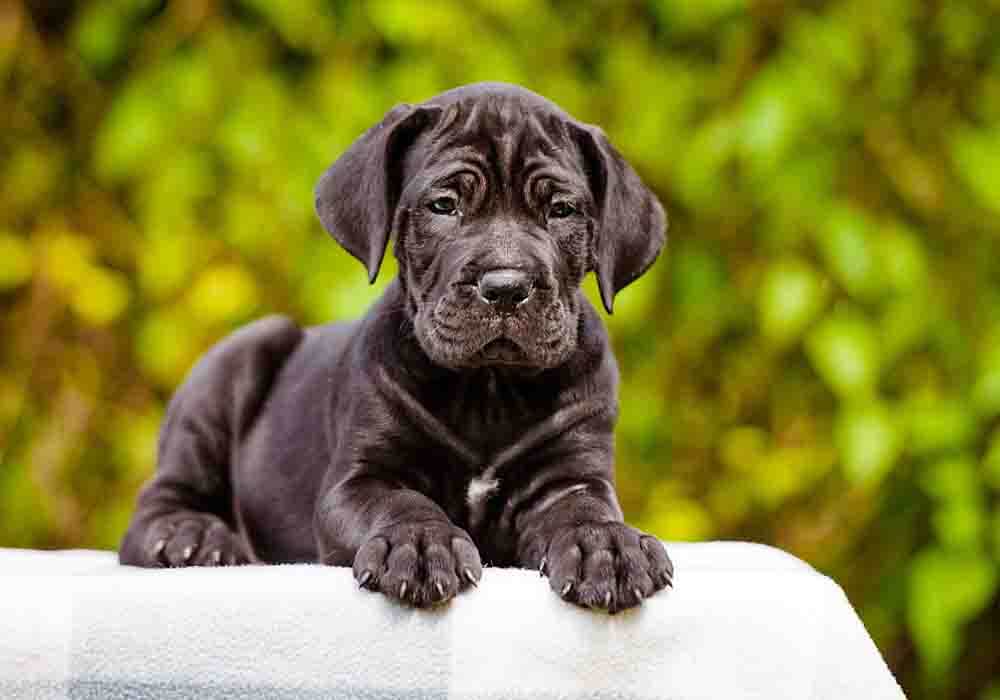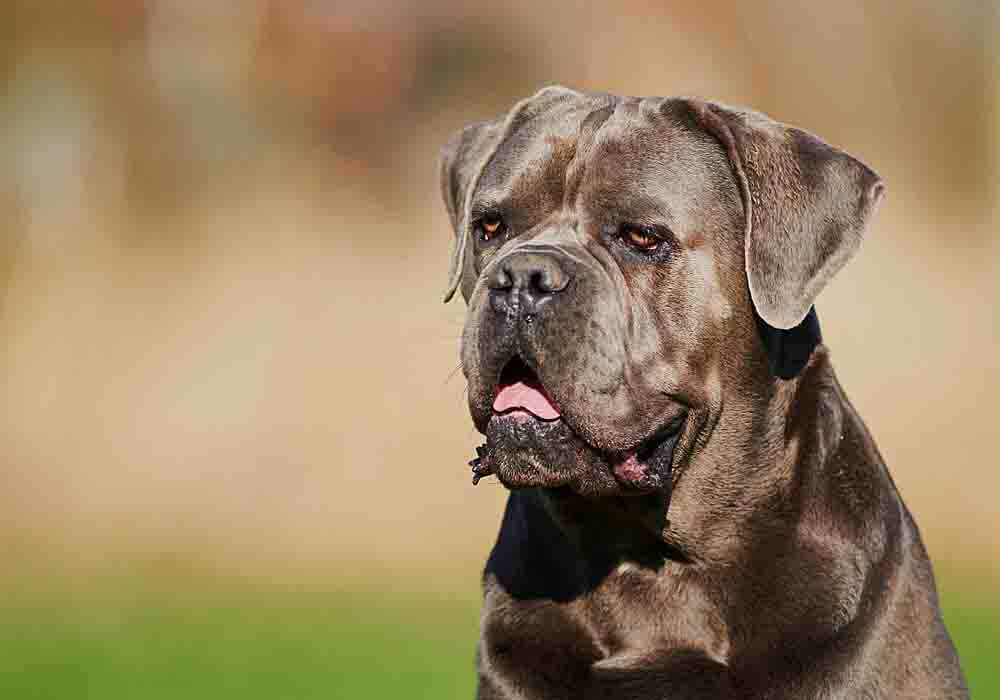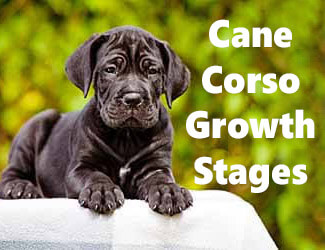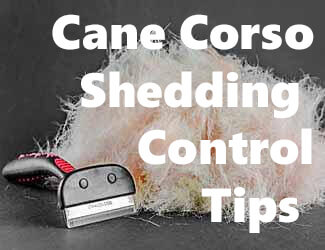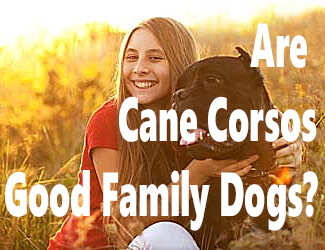Cane Corso Fun
And Interesting Facts
We left no cat unchased
or tree unsniffed to bring you these facts!
by Ken Alden
Here's our Top 18 Cane Corso fun and interesting facts about a dog breed, it's history and lineage which can be traced back to ancient Rome. They would make a great pet to have if you have a large space where they could run and exercise. This breed is also best suited for homes that have experience taking care of dogs.
Read on and learn more about the Cane Corso, including how the breed came to be and how to take care of one. It is also important to know what you can expect from Cane Corso before you bring one home. Read More Below...
Pro-tip: Ever try lifting a Cane Corso? Their weight can hurt not only your back but their joints when they hop down from cars, sofas or even your bed. To protect your back and theirs check out the best Mastiff ramps on Amazon.com now.
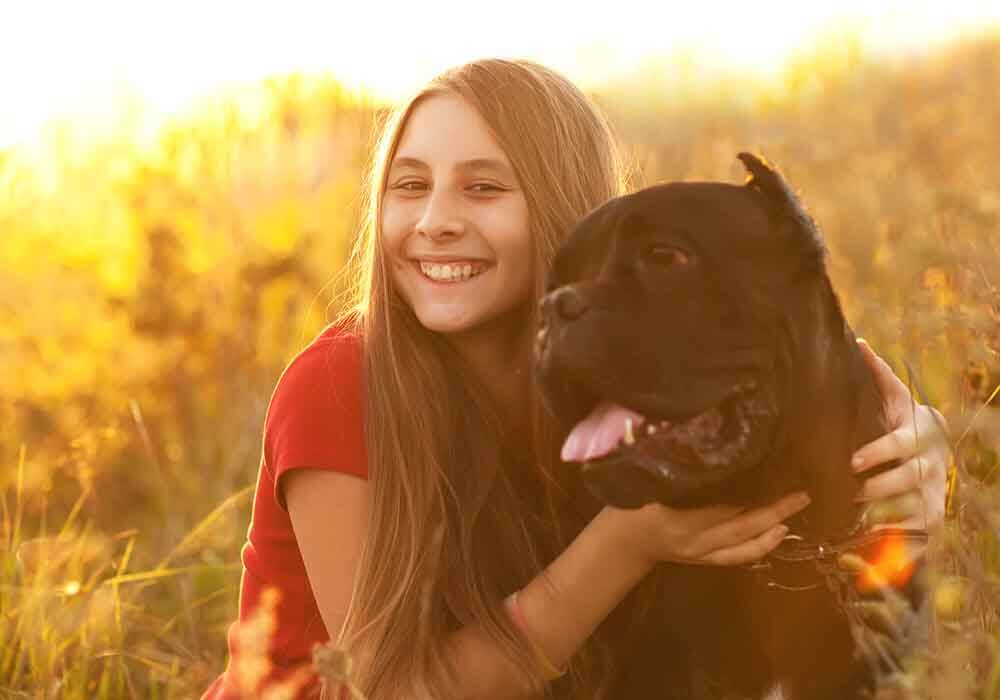
Cane Corso Breed Facts
The Cane Corso is a breed of working dog that originated in Italy and was, in fact, known only in the southern part of the country before 1988. This breed was also considered very rare. This dog is medium-large in size, and they have a strong, sturdy, and muscular build, making them an ideal property watchdog and hunting dog.
This dog has a short but double-layered coat, which makes this breed easy to groom. Its undercoat, meanwhile, varies in length, depending on its home country's climate. The coat sheds lightly all year round but more heavily during the shedding season in the spring.
Cane Corso dogs are intelligent and highly trainable. They may look powerful, unfriendly, territorial, and imposing, thanks to their huge head and heavy and rectangular body, but they are very eager to please and are fiercely devoted to their family. They also respond well to love, affection, and rewards.
Here are more cane corso fun and interesting facts...
#20 The Cane Corso Has an Average Life Span of 10 to 11 Years
A study has found that most Cane Corso dogs live slightly more than nine years and three months old. But they can, however, live much longer than that.
It's interesting to note that the study seems to have found a
correlation between hair color and longevity in these dogs. For instance, black
and brindle haired dogs have a median lifespan of 10.3 years, with some living
up to 13 years. The more brownish dogs, however, have a generally shorter
lifespan at slightly more than seven years to 11 years and four months. cane corso fun and interesting facts
#19 Their Life Span May Be Related to Their Hair Color
The same study looked into 232 Cane Corso dogs from 25 countries and described a potential relationship between the breed's longevity and the color of their hair. Researchers found that most Cane Corso dogs that lived longer had black brindle hair. They live more than 10 years and three months. On the other hand, those with brindle-colored hair lived a slightly shorter life at around 10 years and 47 days.
The black brindle dogs outlived most dogs by slightly more than one year, while outlasting other color dogs by more than two years and 76 days.
#18 Start Training Your Cane Corso While Young
Start training your Cane Corso while he is still a puppy and still at a manageable size. Teach him how to follow your commands and establish that you are the leader of the pack. With firmness and consistency, you should guide your dog and teach him things he can and cannot do.
#17 Even With Socialization, a Cane Corso Is Never Friendly Toward Other People
Early socialization is important so the dog can recognize what is normal and what is a real threat. However, the dog takes its responsibilities as a guard dog seriously, so no amount of socialization will make your dog friendly toward people who are not members of its family.
Pro-tip: Cane Corso anxiety, aggression, destructive chewing, jumping up, fearfulness, and other behaviors can be controlled with the right training program.
Here’s a great course that
addresses these issues along with many other dog training basics: Check it out now!
#16 A Cane Corso Is Loving but Not Demonstrative and Demanding
The dog loves his family, but he is not demonstrative. He would want to be near you, but he won't demand your attention or demand for a belly rub the way other dog breeds do. Despite that, it won’t be healthy to just ignore your dog. Not giving your dog attention and enough exercise or yard time will only lead to him getting aggressive and destructive.
#15 A Cane Corso Should Be Indifferent When Approached
According
to the Italian breed standard, the Cane Corso should be
indifferent when being approached. Moreover, your dog should react only when there
is a real threat. This dog, after all, is also a working breed and can function
under high levels of stress. If a Corso is unable to maintain its dictated
temperament under a stressful situation, it means his temperament is incorrect
for the breed.
#14 A Cane Corso Needs a Job to Do
This is a working dog, so he won't be happy to just lie around the entire day without anything to do. So give him a job, whether he is guarding the house or being your on-leash walking companion.
#13 Only Basic Care and Grooming and Quarterly Bath Are Needed for a Cane Corso
Because a Cane Corso doesn't have a long coat and only sheds minimally, you only need to brush his hair once a week and give him a bath using mild shampoo every three months or when he gets dirty. Basic care for a Cane Corso includes checking his ears every week and cleaning the area when needed. You should also trim his toenails once a month as long toenails are painful for them, and brush his teeth regularly to keep his teeth and gums healthy.
FREE DOWNLOADABLES...
Track the growth of your Cane with our free downloadable PDFs...
For Males
For Females
#12 Cane Corso History Facts
Cani Corsi belongs to a subcategory of working dog breeds known as molossus, an ancient Greek tribe believed to have bred large, big-boned Mastiff-type for giant dogs. When the Roman Empire rose to power, the ones that subdued and occupied the Greek islands brought molossoids back to Italy to breed them to native Italian breeds. What resulted is the Cani Corsi, which were originally used as dogs of conquest.
It is believed that the earlier Cani Corsi were bigger in size compared to today's sleeker version. These fearless dogs of conquest earned their stripes by charging the enemy lines with buckets of flaming oils strapped to their backs. In the fifth century, the Roman Empire collapsed and Italy's legions and their Corsi dogs were out of work. This led to the Corsi adapting to civilian jobs like farming, wild boar hunting, guarding farmsteads and henhouses, and livestock driving.
For centuries after, the Corsi became a familiar sight on farms and pastures that abound in the Italian countryside. However, by the mid-20th century, the breed almost got extinct with the constant invasions of Sicily and the Italian peninsula, the spread of mechanized farming, the many political and economic upheavals, and, of course, the first and second World Wars.
Fortunately, specimens survived. It was only around five decades ago that a team of Italian fanciers worked to revive it. Dr. Paolo Breber most notably became interested in the breed, obtained some of the dogs, and started a breeding program.
In the early 1980s, the Society of Cane Corso Lovers was formed and by the next decade, the Corsi was being exhibited in dog shows in Europe. The first Corso was exported to the U.S. in 1988. In 1993, the International Cane Corso Federation was created in America, and, by 1996, the breed was recognized by the Federation Cynologique Internationale. In 2010, the Cane Corso was recognized by the American Kennel Club.
#11 Fun and Interesting Facts About the Cane Corso
If you’re wondering if Cane Corso is singular or plural, it’s singular. If you have more than one Cane Corso, you use the plural form: Cane Corsi. Here are some more interesting facts you may not have known about the Cane Corso breed.
#10 The Name Cane Corso Roughly Translates From the Latin Term for “Bodyguard Dog.”
This is not surprising considering that this breed is highly territorial, dominating, and protective, which are excellent watchdog traits. And while the dog is loving and affectionate with owners, he is not friendly to strangers. He is also not friendly to other dogs and pets unless they are all raised together.
With its hunting origins, a Corso may, in fact, look at stranger animals as prey and would best consider to kill them. As such, it is essential that their training include socialization early on.
#9 The Cane Corso Is Closely Related to the Neapolitan Mastiff
The Neapolitan Mastiff also came from the traditional catch and guard dogs of central Italy. However, in name and form, the Cane Corso came before its Neapolitan Mastiff cousin. The two breeds are both large and powerful, but while the Cane Corso’s skin is smooth and firm, a Neapolitan Mastiff's is loose. The Neapolitan Mastiff has an abundance of skin, making it hang in heavily in wrinkles, especially on the face.
#8 A Cane Corso Is Less Bulky Than Other Mastiff Breeds
A Cane Corso is well-muscled, but compared to most other mastiff cousins, this breed is less bulky. They are also more agile and athletic and move with more ease and grace.
#7 The Head of the Cane Corso Is Its Most Important Feature
A
Cane Corso's head is massive and imposing. The dog’s forehead is flat and it is
convergent to the muzzle, which is also flat, rectangular, and as wide as it is
long. Its head, according to the official breed standards, has a total length that
reaches around a third of the height at the withers. The head's circumference,
measured at the cheekbones, is more than double the length of the head.
Read on for even more cane corso fun and interesting facts...
#6 The Cane Corso Is Also Known As Dogo Di Puglia, or Dog of Puglia
The breed is also called Dogo di Puglia because while it was distributed throughout the Italian peninsula during ancient times, it was found only in the country's southern region of Puglia in the recent past. After the mezzadria system of share-cropping collapsed in the 1960s, the breed became rare and selective breeding had to be done of the few surviving Corsi from about 1980.
#5 The Cane Corso Was Featured in Many Paintings
The breed has appeared in many classic paintings, including ones by Bartolomeo Pinelli and Andrea Mantegna. They appeared in sculptures, too. Considering that Cane Corso dogs were a common sight in Italy and most of the Renaissance painters are Italian, they are bound to appear in their masterpieces.
#4 The Cane Corso Almost Went Extinct During World War II
yDespite the breed having a multi-century legacy, Cane Corsos nearly got obliterated during the second world war. But thanks to a few remaining dogs and people who showed interest, a breeding program was initiated to keep them from being completely gone.
Pro-tip: Cane Corso's (and their owners) love dog crates…and for good
reasons. Crates keep dogs from mischief while you're away, are perfect for house
training, for traveling by car, and provide the dog a place to de-stress. Check
out the best Mastiff crates on Amazon.com now.
Facts About Cane Corso Puppies
If you are thinking about getting a Cane Corso as a pet, here are some more things you need to know about the breed while they’re still puppies.
#3 Cane Corso Puppies Are Born Chewers
Like any breed of dog, Cane Corso puppies are natural-born chewers. Plus, their small size allows them to easily go under furniture and squeeze into little nooks and crannies, so you can just imagine the amount of damage they can do.
As such, don’t allow them total freedom around the house before they have reached a trustworthy level of maturity. It is also recommended that you keep your puppy busy with play, training, and socialization. Keep in mind that a Cane Corso can be destructive when bored.
#2 Even Puppies As Young as Eight Weeks Old Can Absorb Everything You Can Teach Them
You can start training your Cane Corso puppy as early as several weeks old. Puppy training and early socialization classes are recommended for all types of dogs, but these are a must for large and strong breeds like Cane Corso.
Cane Corso dogs can be dominant and protective, so socialization with other people and animals will help ensure that they grow as well-adjusted and well-mannered adults. Meanwhile, obedience training will let them know you are the boss of the household and not them.
Just be sure to get your puppy vaccinated if you decide to get him into a puppy training class. Instead of classes or formal training, you can do your own training at home and socialize him among other members of the family and your friends. Do not wait until your puppy is six months old to begin training as he will be more headstrong by then.
Read on for even more cane corso fun and interesting facts...
#1 When Picking a Cane Corso Puppy, Choose One Whose Parents Have Nice Personalities
You should pick a puppy from Cane Corso parents that have pleasant temperaments, as well as a one who has been well socialized by the breeder from birth. Each parent should also have a hip evaluation of excellent, fair, or good from the Orthopedic Foundation for Animals, good hip scores from the University of Pennsylvania, and an eye clearance from the Canine Eye Registry Foundation.
Needless to say, do not buy a Cane Corso puppy from a breeder who is unable to provide you with written documentation that its parents were cleared of common Cane Corso-related health problems that affect the breed. Having the dogs checked by the vets is not a substitute for genetic health testing.
Is Cane Corso the Right Dog Breed for You?
Now that you know all these little tidbits about the Cane Corso, how can you be sure that it is the right dog for you?
A Cane Corso is athletic and muscular, with a need for daily exercise to maintain its muscle tone. So if you have an adequately sized property or a house with a large, fenced yard that would allow your dog to walk and run around, this dog is the perfect breed for you. The Cane Corso has origins as a farm dog and this breed would make a fierce bodyguard for your property.
If you live in an apartment, you might want to reconsider your choice. You are better off getting any of those small dog breeds.
A Cane Corso will also need quality time with you. This is especially true if your puppy is still under training and you are still trying to teach him how to respond to stimuli. You will also need time to establish your position as head of the household. Otherwise, the Cane Corso will take over as leader of the pack.
What's more, this breed would be overwhelming for first-time dog parents. So it might be best if you have had previous experience with dogs in general. The Cane Corso may best suit a family with teens and adults instead of a family with toddlers. This is because this dog is a large breed and will easily topple your little kids. Moreover, you will need plenty of effort and time to supervise closely the interactions between your dog and your young children.
If you cannot commit to spending time with your Corso, it is better off somewhere else.
You should also know how to be firm and authoritative and establish your position as leader of the pack. For instance, don't let your Corso get comfortable with behaviors like snapping or growling when he gets moved or touched. Mounting members of the family is also inappropriate. Decisive and quick action is likewise needed for reassertion of your authority.
Cane Corso Fun And Interesting Facts...Some Final Thoughts
A Cane Corso has been around for centuries and this breed has been proven trustworthy, reliable, and extremely protective. This breed is also intelligent and highly trainable. This dog is great to have as a guard dog and pet, but having one still requires a lot of commitment. It is best to learn more about a Cane Corso, including how to care for this breed and how to make sure you can meet all its needs before you get one for yourself.
Return to the top of this Cane Corso Fun And Interesting Facts page

About the Author...
Ken Alden, a dedicated Mastiff owner for over eight years, is acclaimed for his expertise in care, grooming, and training. Read more About Me and my dog Shadow.
- Mastiff Guide Home ›
- Cane Corsos ›
- Cane Corso Fun And Interesting Facts
